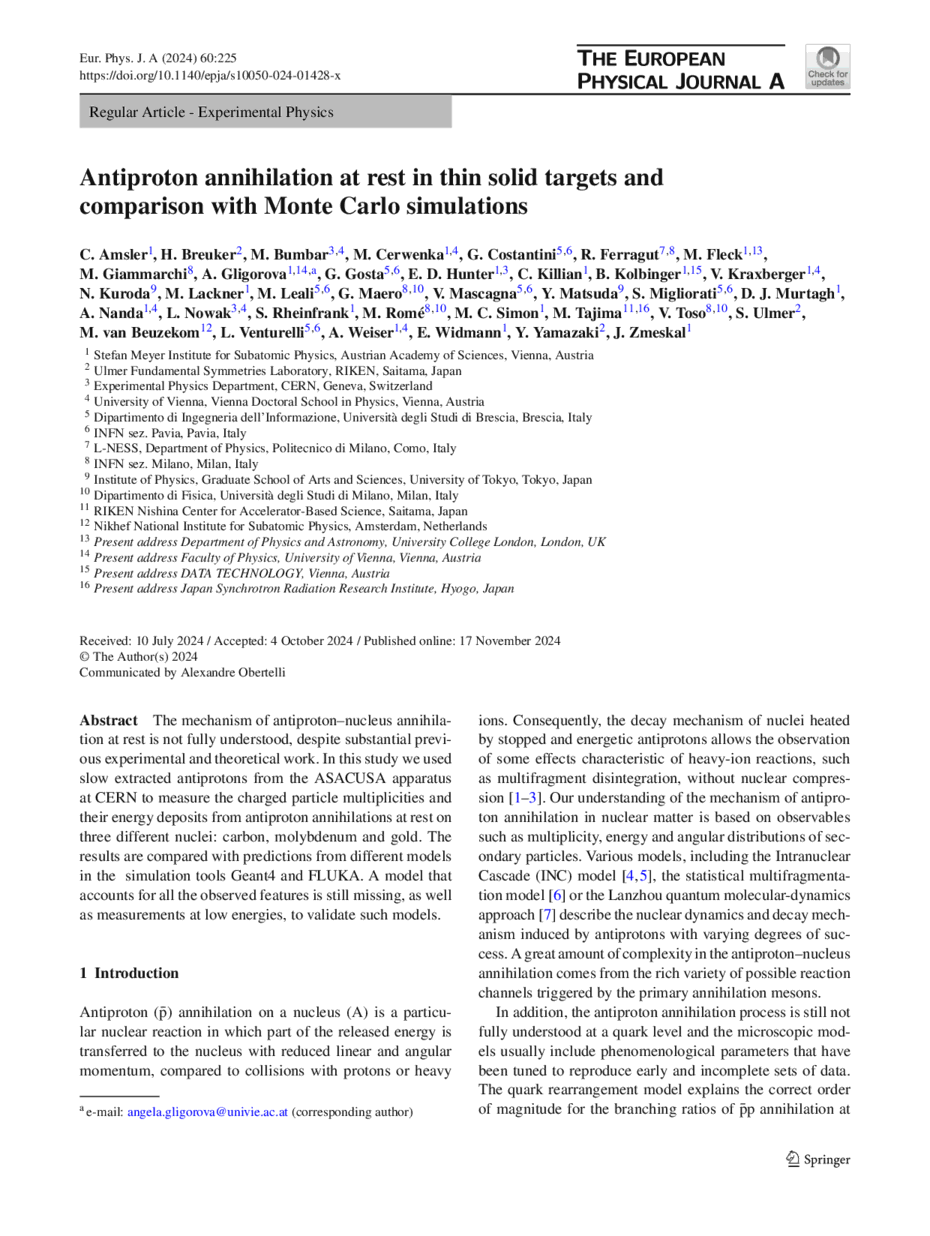https://doi.org/10.1140/epja/s10050-024-01428-x
Regular Article - Experimental Physics
Antiproton annihilation at rest in thin solid targets and comparison with Monte Carlo simulations
1
Stefan Meyer Institute for Subatomic Physics, Austrian Academy of Sciences, Vienna, Austria
2
Ulmer Fundamental Symmetries Laboratory, RIKEN, Saitama, Japan
3
Experimental Physics Department, CERN, Geneva, Switzerland
4
University of Vienna, Vienna Doctoral School in Physics, Vienna, Austria
5
Dipartimento di Ingegneria dell’Informazione, Università degli Studi di Brescia, Brescia, Italy
6
INFN sez. Pavia, Pavia, Italy
7
L-NESS, Department of Physics, Politecnico di Milano, Como, Italy
8
INFN sez. Milano, Milan, Italy
9
Institute of Physics, Graduate School of Arts and Sciences, University of Tokyo, Tokyo, Japan
10
Dipartimento di Fisica, Università degli Studi di Milano, Milan, Italy
11
RIKEN Nishina Center for Accelerator-Based Science, Saitama, Japan
12
Nikhef National Institute for Subatomic Physics, Amsterdam, Netherlands
13
Department of Physics and Astronomy, University College London, London, UK
14
Faculty of Physics, University of Vienna, Vienna, Austria
15
DATA TECHNOLOGY, Vienna, Austria
16
Japan Synchrotron Radiation Research Institute, Hyogo, Japan
a
angela.gligorova@univie.ac.at
Received:
10
July
2024
Accepted:
4
October
2024
Published online:
17
November
2024
The mechanism of antiproton–nucleus annihilation at rest is not fully understood, despite substantial previous experimental and theoretical work. In this study we used slow extracted antiprotons from the ASACUSA apparatus at CERN to measure the charged particle multiplicities and their energy deposits from antiproton annihilations at rest on three different nuclei: carbon, molybdenum and gold. The results are compared with predictions from different models in the simulation tools Geant4 and FLUKA. A model that accounts for all the observed features is still missing, as well as measurements at low energies, to validate such models.
© The Author(s) 2024
 Open Access This article is licensed under a Creative Commons Attribution 4.0 International License, which permits use, sharing, adaptation, distribution and reproduction in any medium or format, as long as you give appropriate credit to the original author(s) and the source, provide a link to the Creative Commons licence, and indicate if changes were made. The images or other third party material in this article are included in the article’s Creative Commons licence, unless indicated otherwise in a credit line to the material. If material is not included in the article’s Creative Commons licence and your intended use is not permitted by statutory regulation or exceeds the permitted use, you will need to obtain permission directly from the copyright holder. To view a copy of this licence, visit http://creativecommons.org/licenses/by/4.0/.
Open Access This article is licensed under a Creative Commons Attribution 4.0 International License, which permits use, sharing, adaptation, distribution and reproduction in any medium or format, as long as you give appropriate credit to the original author(s) and the source, provide a link to the Creative Commons licence, and indicate if changes were made. The images or other third party material in this article are included in the article’s Creative Commons licence, unless indicated otherwise in a credit line to the material. If material is not included in the article’s Creative Commons licence and your intended use is not permitted by statutory regulation or exceeds the permitted use, you will need to obtain permission directly from the copyright holder. To view a copy of this licence, visit http://creativecommons.org/licenses/by/4.0/.





